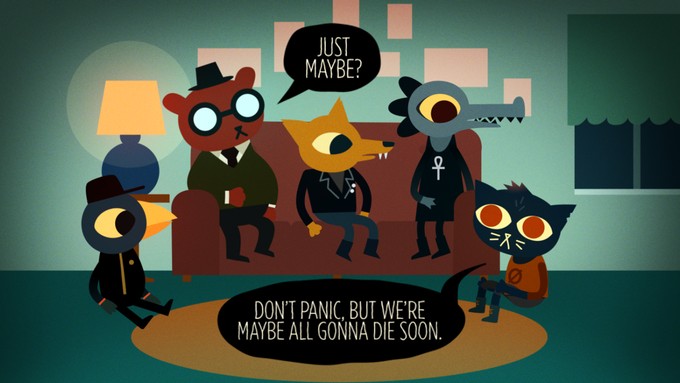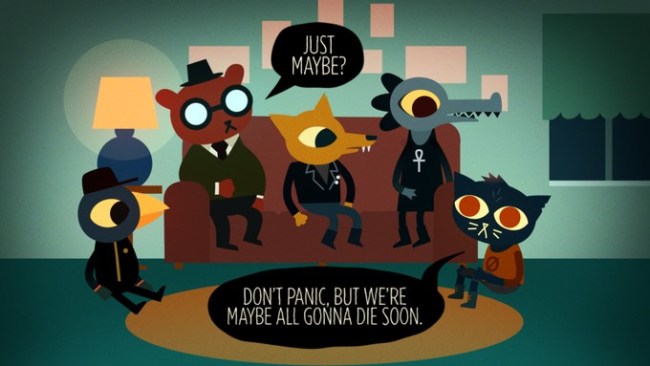Review: Night in the Woods Flourishes in Its Liminality and Unanswered Questions


Spoilers for Night in the Woods follow.
When I was a kid, my mom took my sister and I on a few bus trips. She’d get kind of antsy and want to leave town for a bit, and because she was a single mother, she didn’t exactly have the resources to take us too far or anything–not that I minded, as I was just glad to be going anywhere, really. Hanging out at the bus depot, waiting for our Greyhound to be ready was, strangely enough, one of my favorite things to do. There was something about the liminality of it all; everyone was either coming or going, their minds focused on where they were going or where they had come from, not really thinking about the space they were currently occupying.
In that way, I felt somewhat invisible. I was, after all, just a little kid. Nobody paid attention to me. They were all busy doing something else. I’d sit and I’d watch as a busload of people, weary from their travels, file into and then out of the depot. I’d watch as hopeful folks gathered by the door, anxiously waiting for their trips to be underway.
Night in the Woods begins in this exact liminal space: a bus depot. Mae, an anthropomorphic cat and the protagonist of our story, has left college to return to her hometown of Possum Springs. It’s unclear as to why she’s returning, and we’re left to wonder why throughout nearly the entirety of the game. Whereas many games often shy away or even outright reject the notion of liminality, Night in the Woods revels in it. More than that, it absolutely flourishes in the liminal space it creates for itself.
The game is broken up into a few chapters, and each of those chapters is broken up into a few days. Within each day, you’re given the option to hang out with some of Mae’s old childhood friend group: Bea, an alligator who always has a cigarette hanging out of her mouth, and/or Gregg, a very punk fox who rocks a leather jacket. Later on, Mae is offered the opportunity to hang out with Gregg’s partner, Angus, a dapperly dressed sensitive bear with somewhat hipster-like sensibilities.
The activities you can do with each of them can vary, and you’re really only able to experience so many over the course of one play-through. With Gregg, the options usually revolve around doing some sort of crime (criiiiiiiiiimes), like smashing fluorescent bulbs with a baseball bat, stealing then re-building a freaky old animatronic robot, or a knife fight.
From a gameplay standpoint, each of these interactions can be thought of as a mini-game, little tasks you just happen to do while hanging out with Gregg. His story is intertwined with the things you do while hanging out. He lets slip that he’s moving away from their hometown with his partner, Angus. For Mae, who seems to have returned home in search of some sense of stability, some sense of grounding, the news comes as bit of a shock–literally, as the robot they’re building together winds up electrocuting Mae, casting her into a hallucination of her laptop’s mascot, Sharkle.
With Bea, things are decidedly more chill, though there’s a certain sense of emotional heaviness to her activities, mostly owing to her goth personality, combined with where she happens to be in life right now; you can hang out at the run down, empty mall (where you can do crimes like shoplifting, of course), and end up reminiscing over old pranks, you can go to dinner over at her place, which involves you picking dinner ingredients while shopping at the new mega-supermarket, or you can go an out-of-town party with a bunch of college-aged people. Each of these, save the mall hangout, results in Mae fucking up some kind of thing with Bea, whether it’s through her well-meaning but ultimately misguided intervention in family politics or if it’s through her inability to recognize certain social cues.
Again, Mae, whose heart is grounded in the past, is unable to comprehend the fact that Bea is trying to move on from that past. Bea, in a lot of different ways, was forced to grow up in the time that Mae’s been away, and she isn’t exactly the same Bea she was before Mae left.
Mae’s relationship with her parents is similarly strained, as her sudden return from college wasn’t exactly a welcome thing, given that they had put up a significant amount of resources to send her off in the first place—including mortgaging their home, which they can’t exactly keep up with now.
In addition to wandering around Possum Springs during the day, Mae undergoes a strange journey at night as she has surreal dreams about wandering through a more messed-up, twisted, shadowy version of her hometown and college. These sequences didn’t quite make much sense to me in the moment, though I guess that’s the point: they’re dreams, and they don’t make a whole lot of sense when you’re in them. To a point, you know what to do, just like how in the game, you know enough that you’re supposed to “find” four people playing music somewhere on the map, and then return to where you entered the dream to progress.
You never quite know why you do it, you just know you have to in order to move on—a bit like dreaming, it seems. In the liminal space of the dream, things just make sense because that’s how it goes in that world. In the liminal space of Possum Springs, Mae resists the town’s new status quo, and in so doing, messes things up a little bit for her friends and for herself. Things change, as they are wont to do, and often times, there’s just nothing you can do about it.
It’s this feeling of helplessness in the face of monumental change comes to define Mae and her story. She’s still caught up in that transitional space between being home and being away, and her heart wants the former over the latter, but as the story unfolds, she slowly learns that her firm, obstinate grasp on her outdated idea of home is surely not a welcome one.
On top of all of this, the central conceit of the second half of the story involves Mae’s investigation into the mysterious disappearance of a Possum Springs resident. Mae believes the person vanished under supernatural circumstances, as after the Halloween festival, she witnessed the resident get kidnapped by what she called a ghost. Her friends reluctantly agree to help her investigate, and Mae digs into the history of the town to try to learn more about the town’s haunted history. Their investigation takes them to an old abandoned mine, where they learn that there is, apparently, a secret society of town elders who throw some of the less-ambitious townspeople into a bottomless pit as a sacrifice to ensure the town’s prosperity. Oh, and the pit can talk. Yeah.
On the surface, it seems like a strange addition to a story that already has more than a few things going for it. But consider: the miners perform this horrific deed in order to hold on to their town. They would literally stop at nothing to resist the change that is destined to befall anything and everything that exists in this world. There are no limits as to what they would do in order to keep the town alive. This parallels Mae’s own struggle with the town and its denizens, though perhaps to a much more morbid degree.
I won’t spoil exactly what happens past that point, but suffice it to say that Mae and her friends all learn some hard lessons in what it means to grow up. As they do, Mae falls, fast, out of that strange liminal space between being home and being away. She hits the ground, hard, and any question of where she feels she actually belongs are answered as she sees her investigation straight through to the end.
Mae never really visits the bus depot again—at least, she didn’t in my play-through. She never really returns to that gate of liminality, though in so many ways, she never really leaves the state of mind synonymous with places such as that. She is, in so many ways, still in that bus depot, a casual observer to the comings and goings of her friends who, while she was gone, never really stopped moving. Some are on their way out, and some are on their way home. But for all of them, that bus depot is just another stop on the way to something else. It’s ultimately up to Mae whether she wants to join them on the ride or not.
That, to me, is the decision that lies at the heart of Night in the Woods. We are, all of us, Mae, or Bea, or Gregg, or even Angus. We all grow at our own pace, some faster than others, and—to really beat this bus depot metaphor into the dirt—we’re all scheduled to hop on our busses at different times. We can’t really help that. It is, at the end of everything, up to us whether we want to try to make the most of what we’re given, or give up on it all entirely.
Night in the Woods, like so many story-heavy/story-focused games, has a way of asking more questions than it answers. It’s rich with details and interactions that I honestly can’t fit into one review. But it’s those heavy questions that spawn deep in the pit of my stomach that make me believe it’s a game worth playing, and a story worth experiencing. In my time (and maybe this is me growing up), I’ve come to value those questions, those heavy, leaded blank spaces as extensions of the game itself. Any game that can get me thinking this hard about my own life and my own choices is one that I’ll not soon forget.
Night in the Woods is, hands down, a shining example of exactly that type of game.
(image via screenshot)
—The Mary Sue has a strict comment policy that forbids, but is not limited to, personal insults toward anyone, hate speech, and trolling.—
Follow The Mary Sue on Twitter, Facebook, Tumblr, Pinterest, & Google+.
Have a tip we should know? [email protected]